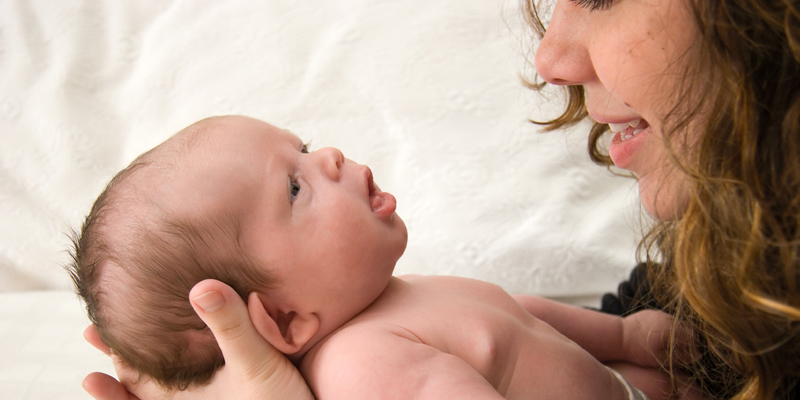
Receptive Language: “Talk to Me. I’m Listening!”
You’ve surely been talking to your baby since the moment she was born, and she’s been taking it all in, looking at you when you talk and listening to every word. This ability to listen is known as Receptive Language skills, and it refers to your newborn’s ability to understand language and other forms of communication in a variety of situations. For example, as she grows, she will learn to recognize facial expressions and emotions.
Studies indicate that your infant will understand language far earlier than she will be able to produce it, so don’t hold back in conversing with her.1 When you speak to her, you may find her smiling and looking at you to show you her interest and willingness to communicate. By the end of her first three months, she will show her Receptive Language skills by turning her head toward familiar sounds and voices, reacting towards tones of voice, and watching people’s hands and faces when they talk.2
During this period, you may also notice your baby beginning to show interest and take part in social conversations. For instance, she may smile, kick her legs, move her hands and arms, or happily suck on her pacifier while listening to nursery rhymes or looking at colors and shapes, all of which lets you know that she’s interested. Because the development of language and speech is so closely tied to later reading and writing skills, it is important to encourage your newborn’s language skills from birth! Take time to use speech, facial expressions, body gestures, and music and songs to communicate with her every day.
(SPECIAL OFFER: Sign up for Playful Bee’s Bee Well developmental learning program to give your baby the best start in life. The first 10,000 children enroll for FREE! Sign up today.)
Play Tips:
Do you want to know how you can support your baby’s development of these Receptive Language skills at this age? It’s easy! Read on for some simple tips to incorporate into your daily play time together.
- Read to your baby frequently while holding her close. Select books that focus on rhymes or repeated words, feature bright colors and simple shapes, and are easy to handle and hold.
- Point out and talk about common everyday objects. When your baby starts understanding what she sees and uses on a daily basis, she may start “talking” to you about these objects because she is excited about her new knowledge.
- Make eye contact and speak directly to your baby in “parentese.” Parentese is an exaggerated, sing song way of speaking to babies. Researchers have found that babies respond to this way of talking more than adult conversation3,4 and that it’s used by parents around the world.
- Use task-centered talking.5 For your child to learn language, it’s not enough for you to just use “parentese” around them nonstop. Young children need to hear task-centered talking: a running narration about what the child is doing or what is being done for them (feeding, dressing, or bathing). It helps young children hear the rhythm and cadence of language and exposes them to vocabulary and syntax. Using task-centered talking around children helps put meaning to what is happening around them.
(SPECIAL OFFER: Sign up for Playful Bee’s Bee Well developmental learning program to give your baby the best start in life. The first 10,000 children enroll for FREE! Sign up today.)
Developmental Milestone:
Has your newborn achieved these Receptive Language developmental milestones yet? If yes, check off all the skill(s) he has already mastered to date using Playful Bee’s developmental milestones tracker. It’s absolutely FREE and so easy to use, just click HERE!
- Begins to babble with expression.
Sources:
1California Department of Education “Language Development Domain.” Retrieved February 24, 2014 from http://www.cde.ca.gov/sp/cd/re/itf09langdev.asp#rl.
2Minnesota Department of Human Services and Department of Health (2007). Minnesota’s Early Learning Guidelines for Birth to 3.
3Public Broadcasting Service. Speak Parentese, Not Baby Talk. PBS Parents. Retrieved December 13, 2013 from http://www.pbs.org/parents/child-development/baby-and-toddler/baby-talk-speaking-parentese/.
4Kutner, Lawrence (2013). The Purpose of Baby Talk. PsychCentral. Retrieved December 17, 2013, from http://psychcentral.com/lib/the-purpose-of-baby-talk/0001223
Playful Bee
Latest posts by Playful Bee (see all)
- Have a Super Fortune Cookie Friday! - February 9, 2018
- All Kinds of Shapes: Your Child Is Learning Simple Shapes, and Drawing Them Too! - November 13, 2017
- Fishing for Sneakers: Create your own Hand-Eye Coordination Fun - November 11, 2017

+ There are no comments
Add yours